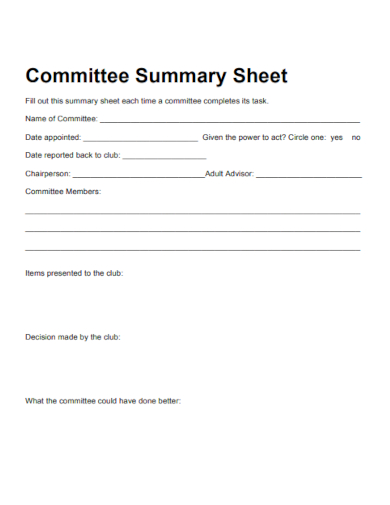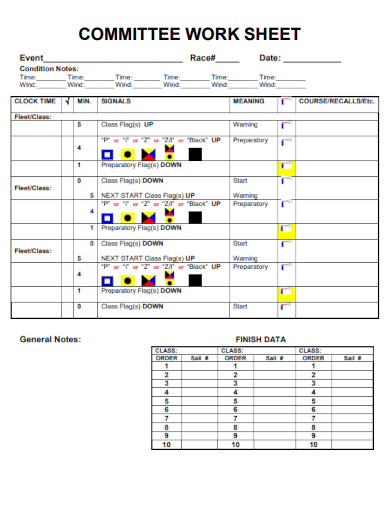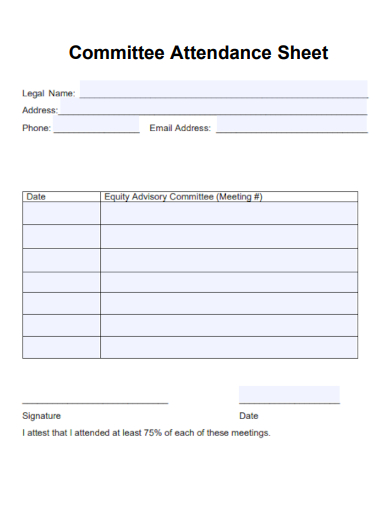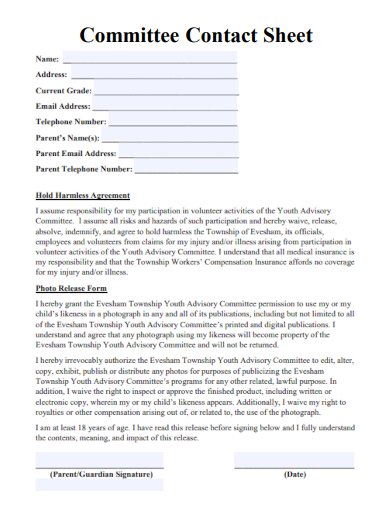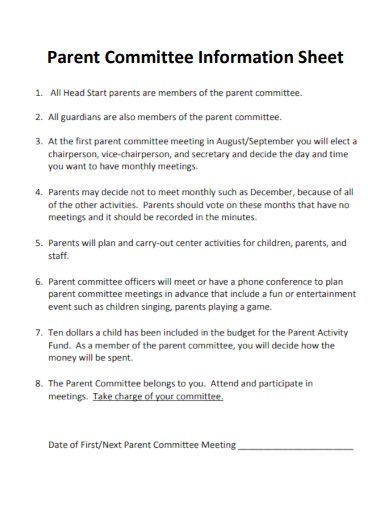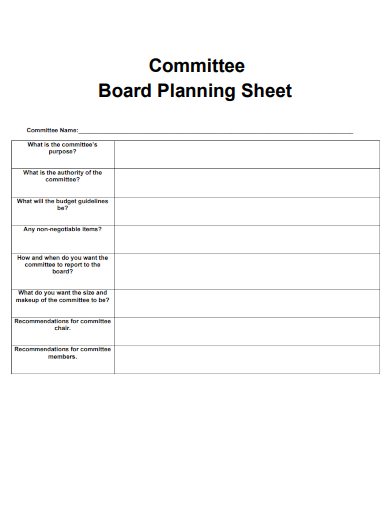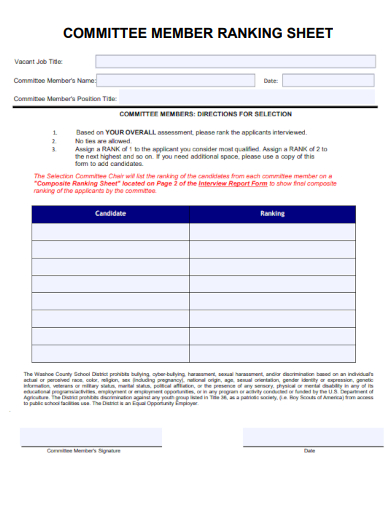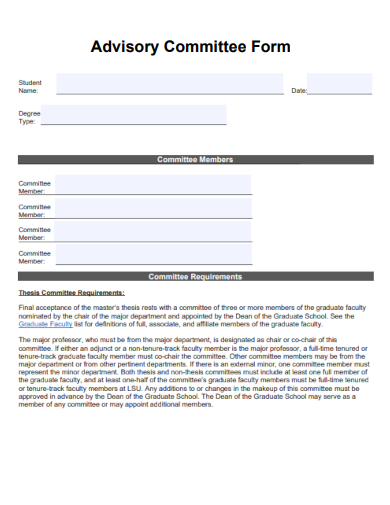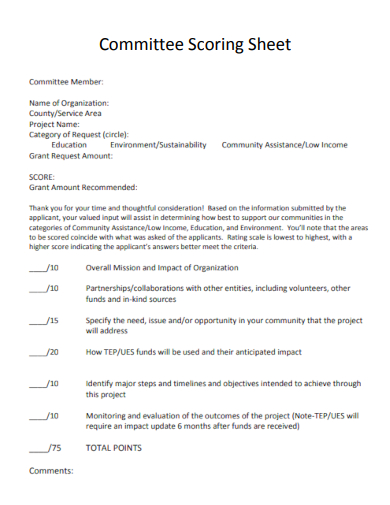Boost your committee’s effectiveness with our Sample Committee Sheet Template. Designed for meticulous record-keeping and streamlined meeting processes, this template is a goldmine for organizational success. Elevate your agenda-setting, note accuracy, and task delegation with a format that caters to clarity and efficiency. Ideal for boards, councils, and teams across the board, our template ensures every meeting’s minutes are captured with precision. Embrace the pinnacle of productivity and make every session count with this indispensable tool.
FREE 10+ Committee Sheet Samples
1. Committee Summary Sheet Template
2. Committee Sign-Up Sheet Template
3. Committee Work Sheet Template
4. Committee Attendance Sheet Template
What is a committee sheet template?
A committee sheet template is a pivotal document used to organize and record the essential functions of a committee meeting. It serves as a standardized format to capture the key components of any meeting including member attendance, agenda items, discussions, resolutions, and assigned tasks. By providing a clear structure, it ensures that all pertinent details are documented efficiently and consistently.
The use of a committee sheet is widespread across various types of organizations, from corporate entities and educational institutions to non-profits and governmental bodies. It aids in maintaining a record of decisions and actions that occur during committee gatherings, which is crucial for accountability, transparency, and follow-up actions.
One of the core elements of a committee sheet template is the agenda section. This segment outlines the topics to be discussed and provides a roadmap for the meeting. It allows members to prepare for discussions beforehand and contributes to a more focused and productive meeting. Agendas typically list items in the order of importance or sequence in which they will be addressed, often with allotted times to keep the meeting on schedule.
Another integral part is the attendance record, which documents the members present and absent. This attendance log is vital not only for record-keeping but also for ensuring that decisions are made with a quorum—a minimum number of members required to validate the meeting’s resolutions.
Meeting minutes are another crucial feature of the template, summarizing the discussions that take place on each agenda item. This includes any debates, member contributions, and the rationale behind decisions made. Minutes serve as an official and legal record of the proceedings and can be referred back to in future meetings or for auditing purposes.
Action items are also noted within the committee sheet template, detailing the tasks assigned to members or subcommittees, complete with deadlines and specific responsibilities. Tracking these actions is essential for holding members accountable and ensuring that decisions lead to tangible outcomes.
Furthermore, a committee sheet may include a section for next steps or follow-up actions, highlighting the future items for consideration or outlining the preparatory work for the next meeting. This forward-looking approach is essential for sustained progress and continuous improvement within the committee’s domain.
In addition to these components, a well-crafted committee sheet template can also provide space for additional notes, references to documents or reports presented during the meeting, and any amendments to previous minutes or resolutions.
For optimal impact, the template must be user-friendly, allowing easy customization to cater to the specific needs of different committees. It should be designed to promote clarity, facilitate ease of use during the meeting, and support post-meeting review processes.
In summary, a committee sheet template is a strategic tool that encapsulates the dynamics of committee meetings into a documented format. It is an indispensable resource that enhances the organization, efficiency, and effectiveness of a committee’s operations, ensuring that every meeting’s objectives are achieved and its outcomes are accurately recorded and implemented.
5. Committee Grade Sheet Template
6. Committee Contact Sheet Template
7. Parent Committee Information Sheet Template
How to create a committee sheet template?
Creating a committee sheet template involves several steps to ensure it meets the specific needs of your committee while maintaining a structure that facilitates effective meetings and clear documentation. Here’s a comprehensive guide to crafting an efficient and user-friendly committee sheet template:
1. Establish the Framework:
Begin by outlining the basic structure. This typically includes sections for the meeting title, date, time, location, attendees, absentees, agenda, minutes, action items, and next meeting details. Choose a logical order that reflects the flow of a meeting.
2. Design the Header:
The header of the committee sheet should include the name of the committee, alongside the meeting’s specific details like date and location. This helps in identifying the document at a glance and sets the context for the content that follows.
3. Detail the Attendance Section:
Create a section to document attendees and absentees, including a space for signatures if required. This can help verify who was present to contribute and vote on committee decisions, ensuring accountability.
4. Outline the Agenda Items:
Designate a portion of the template to list agenda items. Use bullet points or numbered lists for clarity, and leave space to write a brief description of each item. Ensure there’s room for the time allocated to each item to help keep the meeting on track.
5. Record the Minutes:
Allocate a large section for the minutes. This is where the discussions, debates, and decisions for each agenda item are noted. Include subsections for different topics discussed, and provide ample space for detailed notes.
6. Action Items and Responsibilities:
Create a table or list to log action items arising from the meeting. This section should include the task, the responsible party, the deadline, and a status update column to track progress.
7. Add a Section for Next Steps:
Include an area for outlining next steps or items to be carried over to the next meeting. This can help in planning future agendas and ensure continuity.
8. Review and Feedback Mechanism:
Include a space at the end of the template for members to offer feedback on the meeting process. This can be invaluable for improving the efficiency and effectiveness of future meetings.
9. Formatting for Clarity:
Use bold headings, italics, or underline for section titles to differentiate them from other text. Bullet points, tables, and checkboxes can organize information effectively. Ensure the template is clean and not overly crowded, which can detract from its usability.
10. Finalize and Test Your Template:
After creating the template, review it for completeness and clarity. It’s often helpful to test the template during a live meeting to see if it captures information effectively and to make adjustments based on feedback from the committee members.
11. Convert to a Reusable Format:
Save the committee sheet template in a format that can be easily accessed and edited, such as Microsoft Word or Google Docs. Consider creating a PDF version for distribution to maintain consistent formatting.
12. Accessibility and Distribution:
Make the template readily available to all committee members, and consider using collaborative tools like cloud storage for easy access and version control.
13. Continuous Improvement:
The committee sheet template should be a living document, open to revisions as the needs of the committee evolve. Regularly review and update the template to ensure it remains an effective tool for meeting management.
In summary, creating a committee sheet template is about crafting a document that streamlines the meeting process and ensures that all necessary information is captured succinctly and systematically. A well-designed template is an asset to any committee, contributing to more organized, efficient, and productive meetings.
8. Committee Board Planning Sheet Template
9. Committee Member Ranking Sheet Template
10. Advisory Committee Form Template
11. Committee Scoring Sheet Template
What should be included in a committee report?
A committee report is a formal document that communicates the findings, decisions, and recommendations of a committee to a larger group, organization, or governing body. To ensure it is comprehensive and serves its purpose effectively, certain key elements should be included:
1. Title Page:
The title page should feature the report’s title, the name of the committee, the date of the report’s completion, and any other relevant identification information like the report number if applicable.
2. Table of Contents:
A clear table of contents is crucial, especially for longer reports, to allow readers to easily navigate to specific sections of the document.
3. Executive Summary:
This is a concise summary of the report, highlighting the purpose of the committee’s work, key findings, decisions made, and recommendations. It allows readers to grasp the essence of the report without reading the full document.
4. Introduction:
The introduction should establish the context of the report by detailing the committee’s mandate, objectives, and the scope of the issues addressed. It should also explain how the committee approached its task and the nature of the problems it was set to investigate or resolve.
5. Methodology:
In this section, outline the methods the committee used to gather information, such as surveys, interviews, research, or analysis of data. It provides transparency and lends credibility to the report’s conclusions.
6. Findings:
The findings are the results of the committee’s work, including facts discovered, data collected, and insights gained. This section should be presented logically and be supported by evidence.
7. Discussions:
Here, the committee should interpret the findings, explaining their significance and how they relate to the committee’s objectives. Any divergent views or debates within the committee during its proceedings can also be documented here.
8. Conclusions:
The conclusions are drawn directly from the discussions and findings. They provide a summarized understanding of what the committee has determined or resolved about the issues at hand.
9. Recommendations:
Based on the conclusions, the committee should list its recommendations. These are actionable suggestions or advice for decision-makers on how to proceed. Recommendations should be clear, feasible, and prioritized.
10. Appendices:
Any additional material that supports the report but is too detailed for the main body can be included as appendices. This may consist of raw data, detailed financials, transcripts of interviews, or full survey results.
11. References:
If the report cites external sources, a references or bibliography section should be provided, following the appropriate citation style.
12. Acknowledgements:
This optional section can recognize individuals or organizations that significantly contributed to the committee’s work.
13. Approval:
The report should include a signature line or approval section for the chairperson or authorized committee members to endorse the document.
The committee report should be written clearly and professionally, using objective and neutral language. It should be formatted for easy reading, with headings, subheadings, and bullet points or numbered lists to organize content effectively. The use of charts, graphs, and tables is encouraged to illustrate data visually. The ultimate goal of the report is to inform and facilitate informed decision-making by its recipients.
Related Posts
FREE 5+ Construction Bid Sheet Samples in PDF | MS Word | Excel
FREE 15+ Construction Timesheet Samples in PDF | MS Word
FREE 26+ Construction Sheet Samples in MS Word | Google Docs | Excel
FREE 20+ Continuation Sheet Samples in PDF | MS Word
FREE 25+ Program Sheet Samples in MS Word | Google Docs | Pages | PDF
FREE 33+ Student Sheet Samples in PDF | MS Word
FREE 32+ Planning Sheet Samples in PDF | MS Word
FREE 10+ OC Sheet Samples in PDF
FREE 10+ Beat Sheet Samples in PDF
FREE 3+ Paper Sign Up Sheet Samples in PDF
FREE 50+ Summary Sheet Samples in MS Word | Google Docs | Google Sheets | Excel | PDF
FREE 10+ Cleaning Bid Sheet Samples [ Commercial, House, Residential ]
FREE 10+ Group Sheet Samples in PDF
FREE 10+ Family Group Sheet Samples in PDF
FREE 5+ Printable Blank Signing in Sheet Samples in PDF

